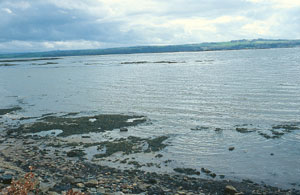 |
Crombie Point is situated on the north shore of the
This mark is easily accessed from the
From the
1 The Fence End
When you drive down to the waterfront, the road goes left or right. Turn left until you come to a small area to park your car. From here look left and you will see the fence running around the MOD site. Fish in front of the corner on the rock ledges for good bags of eels. Do not go past the fence end because you will be asked to move by the MOD. Fish the flooding tide casting close to the weed to pick up the better fish.
2 Muddy Bay
Directly in front of the car park there is a small muddy bay. Fish here from the hard stances to catch flounders and eels. Again fish the flooding tide for the best results. Cast short and as the tide floods, walk back, paying line out, leaving your rig right in the edge of the flooding tide. Try twitching your baited rig back to increase takes. Ragworms will often fish well here, along with peeler crabs.
3 The Old Pier
This will be the first thing you see as you arrive at the water’s edge; a small pile of rocks going out about 30 yards into the sea. Fish either side of this platform to target the flounders and eels, although the right-hand side can be more productive. During large tides a sand bar is exposed in front of the pier. On the larger tides you can expect good catches as the flooding tide covers the sand. Again, casting short can pay dividends.
4 Right Of The Old Pier
This area can be one of the most productive marks during larger tides. The fish seem to pass the front of the pier as they make their way from their low-water residence to the bay on the right. Peeler crabs work best here for the flounders, but casting close to the bottom of the pier will search out the eels. This mark is best fished during the flooding tide.
5 The Corner
When you arrive at the waterfront, turn right and head west along the shore looking for a suitable parking site. Fish in the corner over low water for flounders using peeler crabs as bait. Good fish can show here, but they are usually outnumbered by smaller fish. Vary your casting distance to search out the fish. If you are losing tackle due to the ledges, try and step up to 25lb mono straight through for close-range work.
6 The Ledges
Follow the directions for the previous mark until you find a suitable parking place. Walk out on to the ledges and fish the gutters between the ledges during the flood. Use 25lb main line here and a rubbing leader to combat the rock ledges. This area will usually see the least numbers of fish, but they tend to be bigger. Fish will often be caught right at your feet, so it pays to fish the gutter directly in front of you.
Tackle Shops
Deals On Reels, 22 Bruce Street, Dunfermline. Tel: 01383 728108
TSF Top Tip 1
Step up your main line to 20lb or 25lb when fishing the rougher marks or you will certainly lose a lot of gear.
TSF Top Tip 2
Try tipping your baits off with a sliver of mackerel for more bites from flatties. Also try a large mackerel bait for a bonus bass.





